
Jimi Hendrix is rock’s most important and influential guitarist, rightfully revered as one of the most significant musicians of all time.
More than a half-century ago, the Jimi Hendrix Experience’s 1967 debut release, Are You Experienced, included this bold proclamation: “Be forewarned. Used to be an Experience meant making you a bit older. This one makes you wider. Jimi Hendrix breaks the world into interesting fragments, and then reassembles it. You hear with new ears after being Experienced.” ’60s record-company hype? Absolutely, but also 100 percent true.
All these decades later, Hendrix’s playing on Are You Experienced and his subsequent recorded performances remains among the freshest and most exciting music ever heard, and his influence as a guitarist, composer and sonic innovator continues to resonate with today’s youngest generation of guitarists.
In this lesson, we’ll explore how Hendrix’s music has inspired the distinct, signature styles of six of today’s top players – Melanie Faye, Christone “Kingfish” Ingram, Marcus Machado, Ayla Tesler-Mabé, Joanne Shaw Taylor and Ayron Jones.
Melanie Faye
25-year-old Melanie Faye is a phenomenal guitar player from Alabama, now based in Nashville, who brings a jazz/R&B sensibility to Hendrix’s music, as evidenced in her creative and expressive arrangement of his classic ballad Little Wing.
Figure 1 illustrates some of the techniques and chord voicings Faye employs in her cover of the song. The example begins with a beautiful Eadd2 chord voicing played in 1st position, which is reverse raked by dragging the pick upward across all of the strings, sounding each string individually while allowing all of them to ring together.
This is followed by lush voicings of F#m7add4, G#mb6 (or Eadd2/G#) and Amaj9 that include the open top two strings. You’ll hear Hendrix utilize these kinds of chord voicings on songs such as May This Be Love, One Rainy Wish, Angel and others.
In bar 4, an Am9 voicing is embellished with a quick slide up and down the high E string between the 7th and 8th frets, followed by a pull-off to A at the 5th fret. Faye loves to use quick slides and pull-offs like these, and you’ll hear her utilize this technique a lot in her playing. The bar ends with a descending lick that resolves to E major in the subsequent bar, setting up the shift to her take on Little Wing.
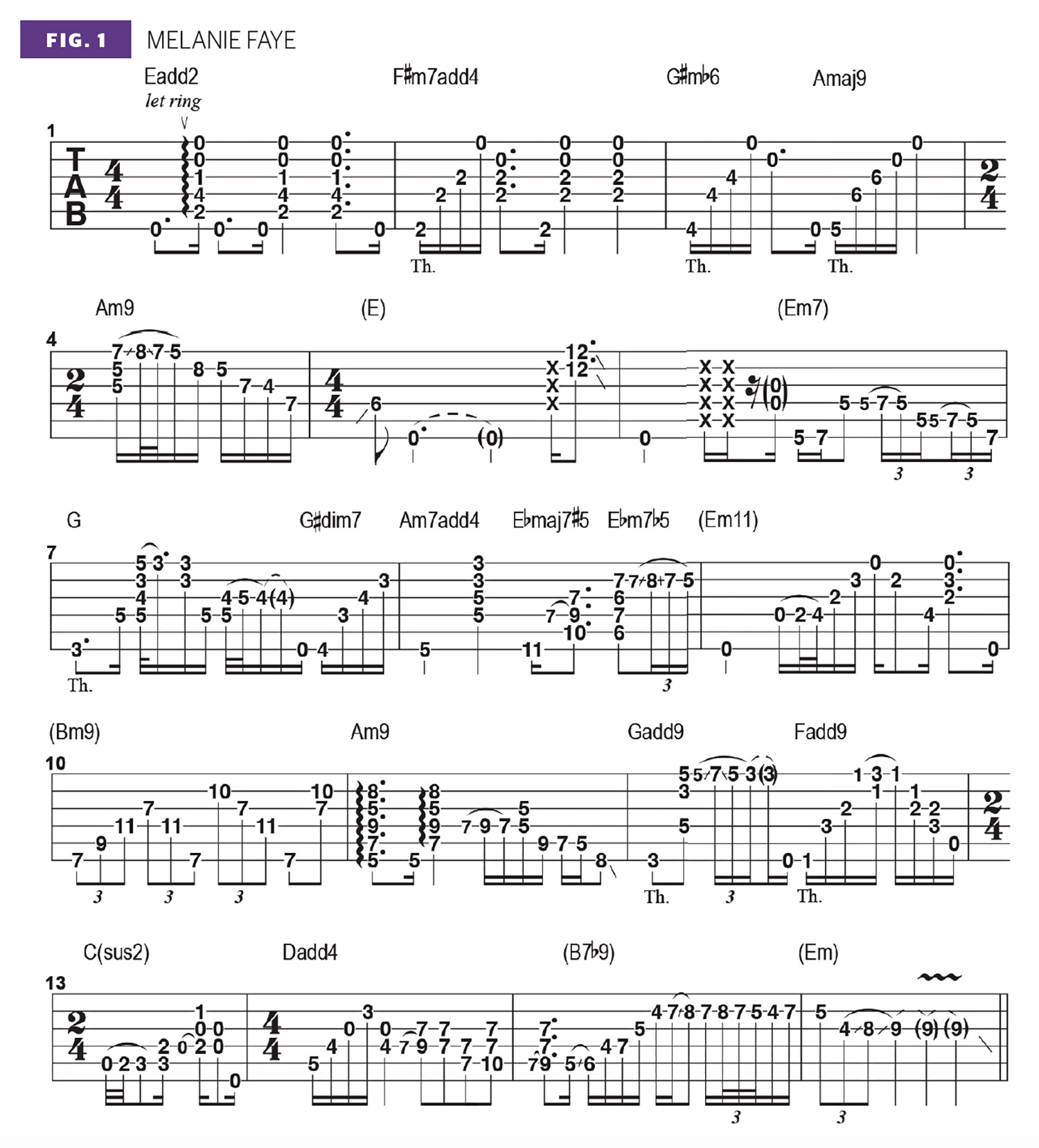
In bars 6 and 7, played over Em and G, quick hammer/pulls are used as chordal embellishments in the same kind of way that Hendrix decorated his phrases in Little Wing, as well as in songs like Castles Made of Sand, Bold As Love and Have You Ever Been (to Electric Ladyland).
At the end of bar 7, a G# diminished 7 chord is arpeggiated (each note is picked individually) setting up the subsequent Am7add4 in bar 8. The jazz sensibility is revealed via the Eb maj#5 and Ebm7b5 chords at the end of this bar, and this colorful move brings us back to the tonic, Em7add4, which is articulated with a quick double hammer-on and more chordal arpeggiation.
Bars 10 and 11 include wide-stretch chord voicings for Bm9 and Am9, and bar 11 culminates with a very Hendrix-like descending phrase that sets up the Gadd9 chord in bar 12. The following Fadd9, Csus2 and Dadd4 chords are all arpeggiated, and in bar 15, a single-note phrase outlines an Eb diminished 7 arpeggio (Eb, F#, A, C) and alludes to a B7b9 chord, which then resolves satisfyingly to Em.
Christone “Kingfish” Ingram
One of the most exciting young blues guitarists on the scene today is Clarksdale, Mississippi’s Christone “Kingfish” Ingram, who, at just 24 years old, has turned heads and earned accolades far and wide.
Writer Tom Moon describes Ingram’s playing as “Astounding… it’s almost as if he is singing through the guitar.” Ingram often covers Hey Joe and, not unlike Faye, he likes to substitute more complex chord voicings during the progression before unleashing very Hendrix-inspired, fiery blues-rock solos.

Figure 2 presents a rhythm part akin to Ingram’s approach to Hey Joe. As opposed to sticking with the original song’s standard major-chord progression of C - G - D - A - E, the harmony is broadened here, starting with arpeggiations of C6/9 and G6/9. Both of these chords include the notes E and A, fretted on the D and G strings at the 2nd fret, respectively.
This is followed by Dsus4 resolving to D and Asus4 resolving to A. The progression wraps up with a 1st-position Em7 voicing that includes the open D, G and high E strings.
The song’s form is built from a repeating four-bar progression, and at the end of each four-bar group, as shown in bars 4 and 8 in this example, signature single-note fills are added, which set up the return to the top of the form.
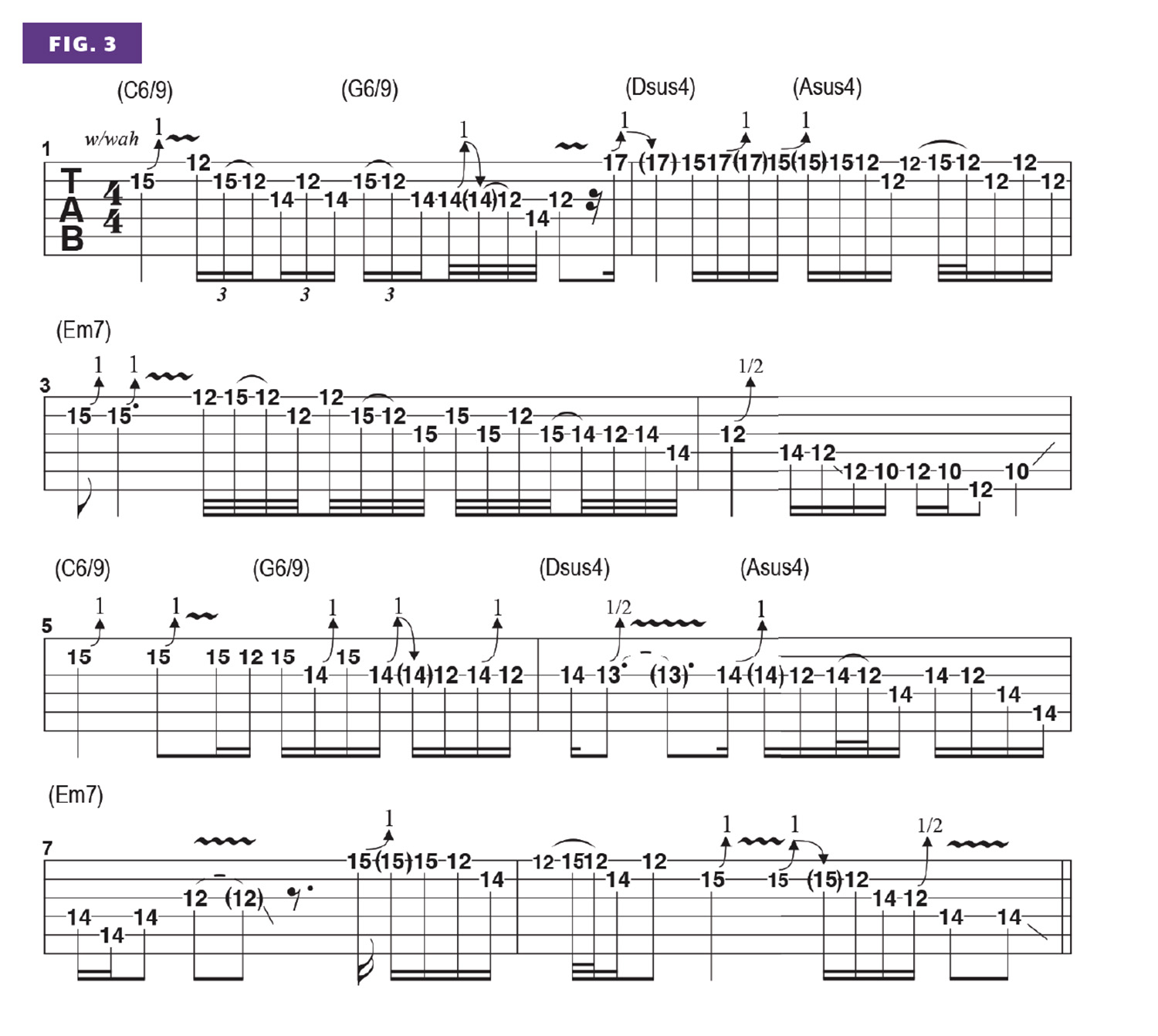
Figure 3 is an eight-bar solo played over this same repeating progression in Ingram’s style. Utilizing a wah pedal with a nod toward Hendrix’s sonic palette, the solo is rooted in lines based on the E minor pentatonic scale (E, G, A, B, D) and the E blues scale (E, G, A, Bb, B, D).
It begins with a heavily vibrato-ed whole-step bend from D up to E, played on the B string’s 15th fret. The phrasing in bars 1 and 2 is based primarily on 16th-notes and 16th-note triplets. In bar 3, a quick descending phrase is played across beats 3 and 4 in a rhythm of 32nd notes, à la Ingram’s fiery soloing approach.
The remainder of the solo is played primarily in 16th notes, with an emphasis on lines that evoke a clear sense of melodic development, combined with a beautifully controlled finger vibrato.
Signature elements like these make Ingram’s soloing sound so pleasing and appealing to listen to. Along with the influence of Hendrix, one can also pick up on techniques that Jimi had learned from listening to his heroes, such as Albert King, B.B. King, Buddy Guy and Otis Rush.
Marcus Machado
Marcus Machado tips his hat to his primary influences with the title of his debut album, 2021’s Aquarius Purple, as the guitarist cites Hendrix and Prince as major inspirations.
Marcus’ music is more rooted in classic and contemporary R&B/soul than Faye’s or Ingram’s, but one can hear elements of Hendrix’s influence in his playing, as well as the influence of the great, pioneering R&B/soul singer, songwriter and guitarist Curtis Mayfield.
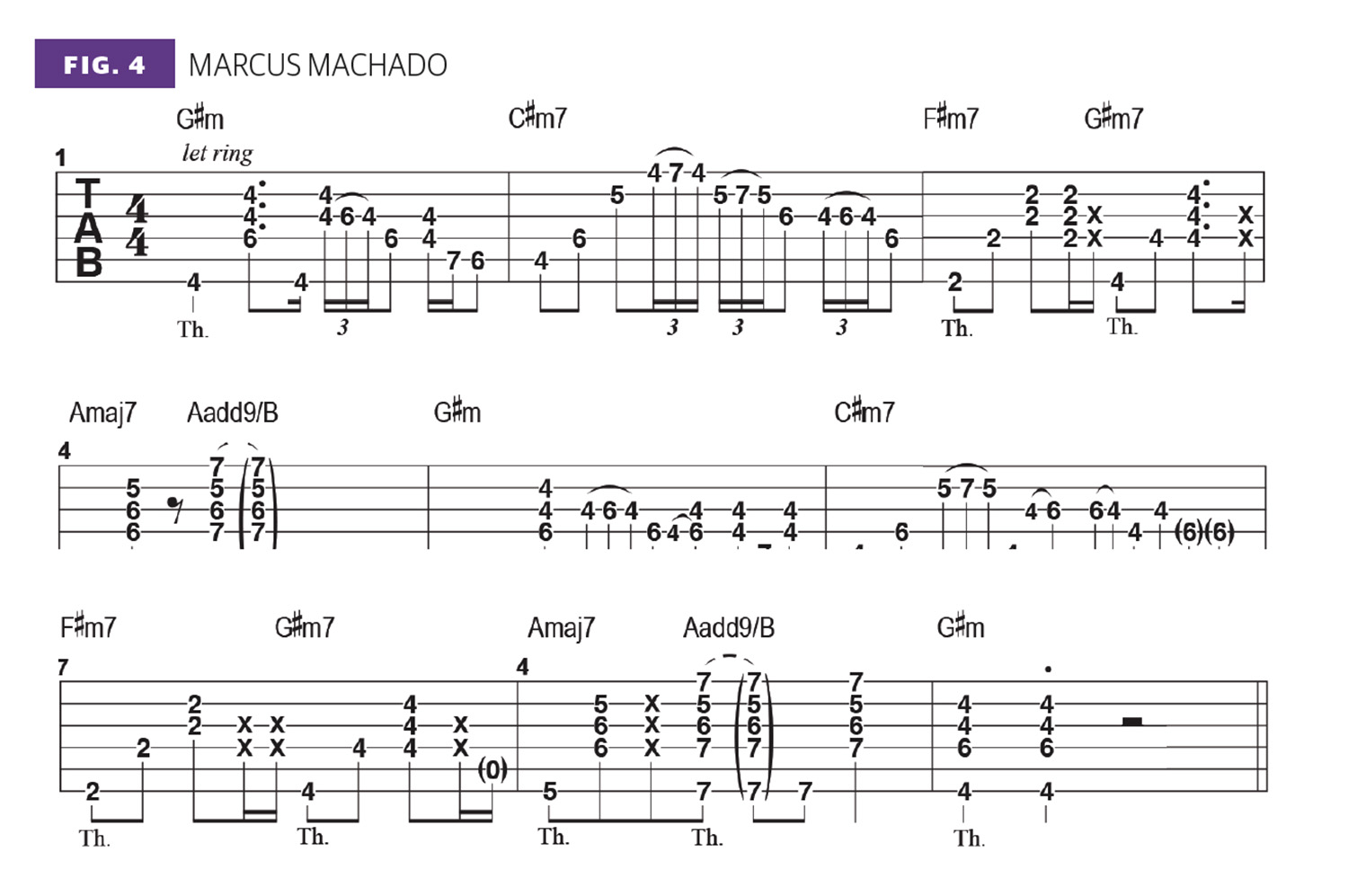
Figures 4 and 5 are played in Machado’s style. Figure 4 presents a repeating four-bar rhythm part that evokes the classic soul style, built from the progression G#m - C#m7 - F#m - G#m7 - Amaj7 - Aadd9/B.
We’re in the implied key of E major here, though an E chord is never actually played. As shown throughout the figure, the initial G#m and C#m7 chords are embellished with single-string hammer/pulls, a technique Hendrix learned from Mayfield and Bobby Womack and can be heard on Little Wing, Villanova Junction and Castles Made of Sand. Be sure to keep a firm grip on each chord voicing as you perform these melodic embellishments, allowing the held notes to ring.
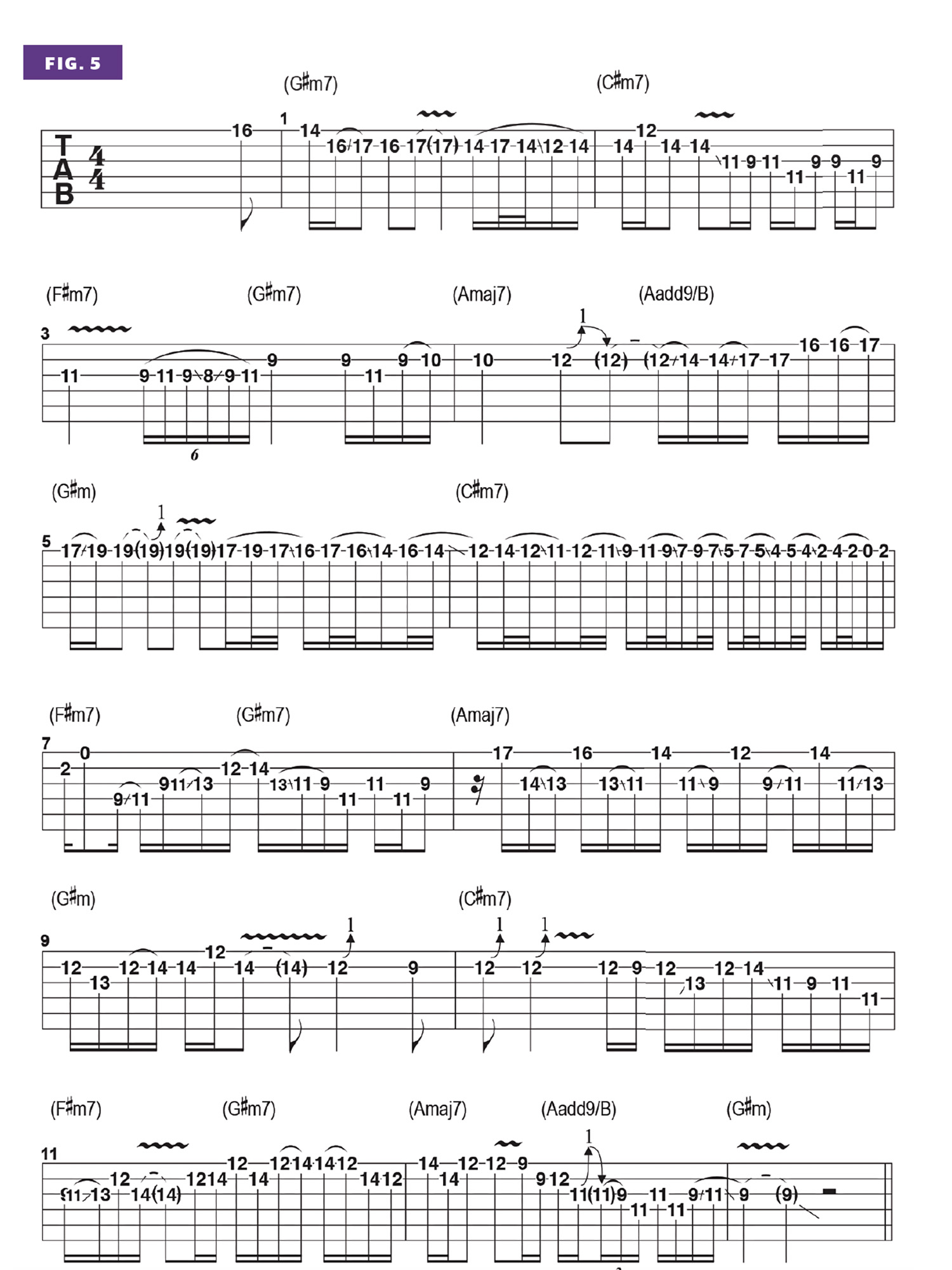
Figure 5 offers a solo played in Machado’s style. The lines are firmly rooted in the E major scale (E, F#, G#, A, B, C#, D#), with specific pitches targeting the underlying chord tones in order to strengthen the connection between the solo and the progression. For example, the solo begins on a G# note, the root note of the accompanying G#m chord, after which the line descends and lands on C#, just as the C#m7 chord is sounded.
Across most of bars 5 and 6, a fast descending phrase is played in a combination of 16th notes and 32nd notes, articulated repeatedly with hammer-ons, pull-offs and finger slides. One can hear Hendrix utilize this technique in his solos on May This Be Love, Hear My Train a’ Comin’ and Voodoo Child (Slight Return).
The improvisation in bar 8 is based on sliding octave shapes fretted on the high E and G strings. Hendrix employed sliding octaves in many of his songs and solos, prime examples being Third Stone from the Sun and Villanova Junction. The example wraps up with lines based on the E major pentatonic scale (E, F#, G#, B, C#), a scale that works well over all of the chords in the progression.
Ayla Tesler-Mabé
Just 22, Ayla Tesler-Mabé is a guitarist and multi-instrumentalist from Vancouver, Canada. Tesler-Mabé has a very unique style, marrying contemporary R&B music with an aggressive, blues-drenched soloing style that also combines elements of jazz.
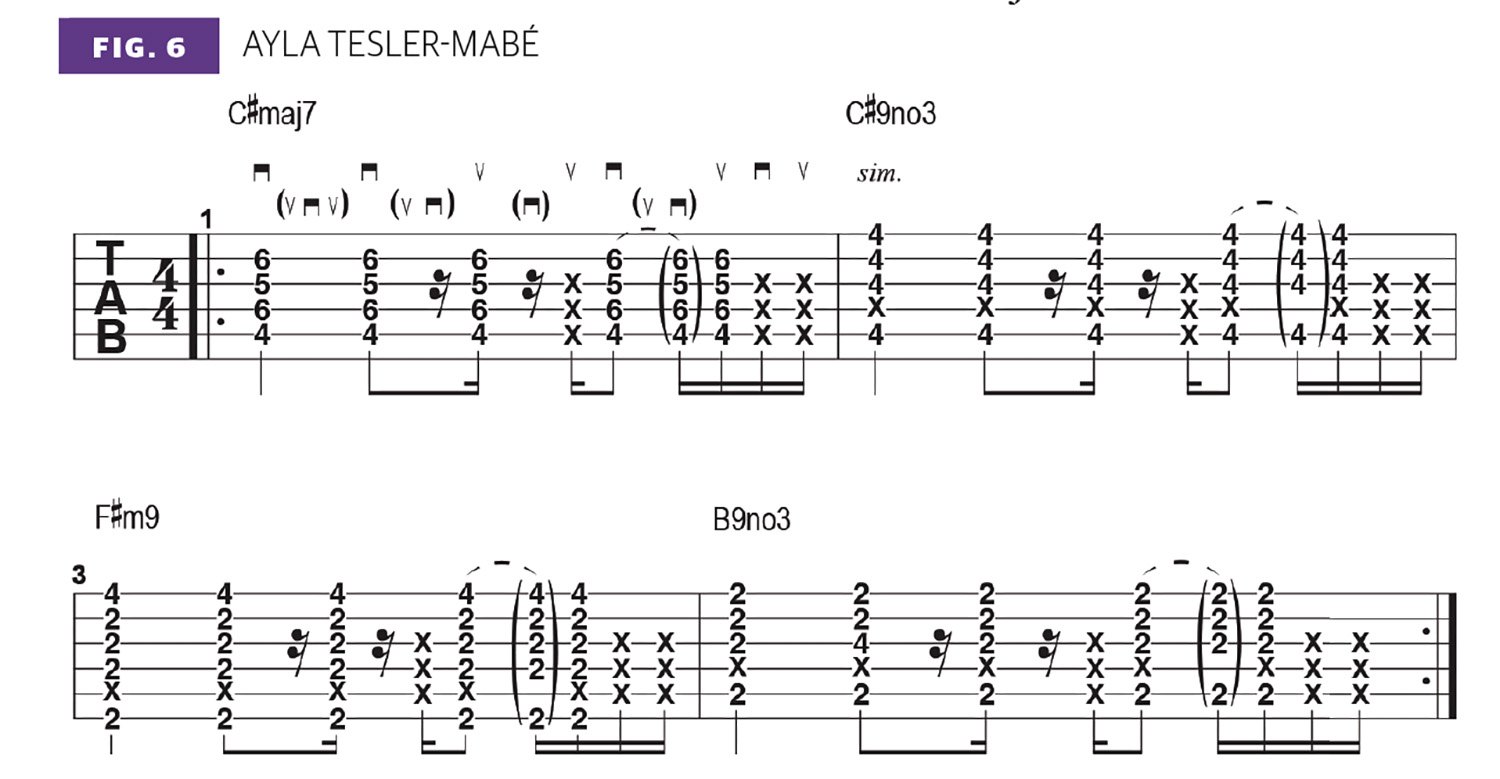
Set to a funky, moderate-tempo R&B/soul groove, Figure 6 is a repeating four-bar progression that moves from C#maj7 to C#9no3 to F#m9 to B9. All of the chords are played with the same syncopated rhythmic phrasing and flowing 16th-note pendulum strumming technique, with fret-hand muted “dead-string” accents added (indicated by X’s).
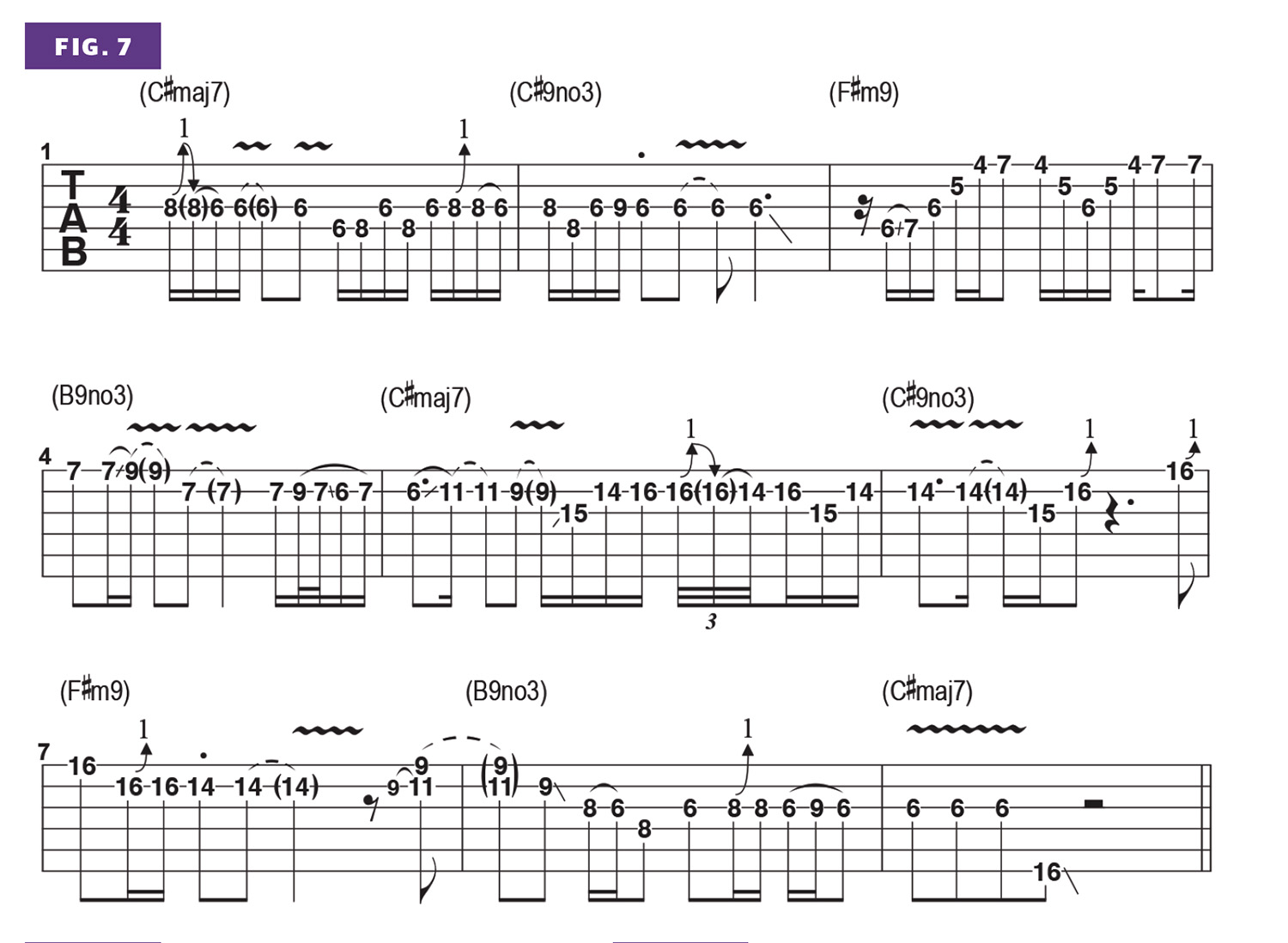
Figure 7 presents an improvised solo played over this progression in Ayla’s style. It sticks primarily with the C# major pentatonic scale (C#, D#, E#, G#, A#), with nods toward the influence of Hendrix, as well as that of B.B. King.
Tesler-Mabé also uses a hard pick attack, which adds expressiveness and assertiveness to her lines. Over the F#m9 chord, the solo moves into jazzier territory, with the notes of an Amaj7 arpeggio (A, C#, E, G#) superimposed over F#m7, implying an F#m9 sound (F#, A, C#, E, G#), starting on the minor 3rd, A.
In the second half of bar 5 into bar 6, the solo moves up to 14th position with blues-type phrases played out of what is often referred to as the “B.B. box,” leaning on the notes A#, C#, D#, E# and G#.
Joanne Shaw Taylor
Another of today’s premiere guitarists is Britain’s Joanne Shaw Taylor, whose 2021 release The Blues Album reached Number 1 on the Billboard Blues Albums chart. Shaw Taylor is also a multiple winner of the best Female Vocalist and Songwriter of the Year at the British Blues Awards shows. The Blues Album, as well as Blues from the Heart Live and Nobody’s Fool, were released on Joe Bonamassa’s Keeping the Blues Alive label.
In 2017, Shaw Taylor released a video of herself performing live at Hendrix’s one-time London flat at 23 Brook St. in London’s West End. “Without Jimi Hendrix’s music, I wouldn’t be the songwriter or guitarist I am,” Shaw Taylor said.
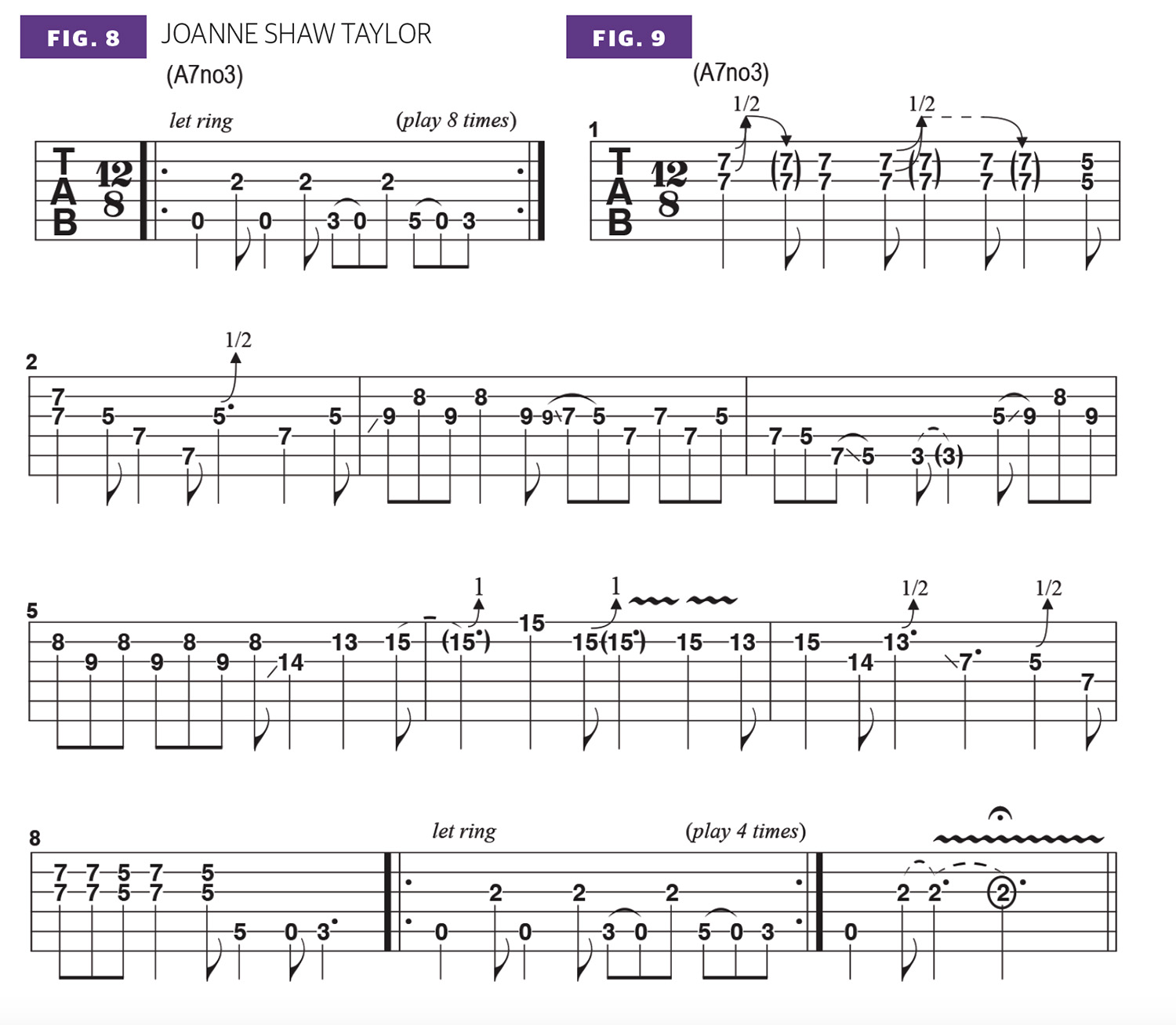
Figure 8 shows a repeating one-bar riff, played in a 128 shuffle feel. This one-bar “boogie” riff is reminiscent of the music of John Lee Hooker and Canned Heat’s On the Road Again, as well as Billy Gibbons’ riffing on ZZ Top’s La Grange. With the A chord held firmly at the 2nd fret, this part emulates the sound of open A tuning, à la John Lee Hooker, as a low-note figure is added and articulated with pull-offs.
Figure 9 presents a solo played in Shaw Taylor’s style, kicking off with two-string bends sounded by barring the 3rd finger across the G and B strings. Two-string bend-and-release licks like these were pioneered by T-Bone Walker and Chuck Berry, who were both primary influences on Hendrix.
In bars 3 and 6, the phrase slides up to E, on the G string’s 9th fret, and then alternates between E and the G note above it, on the 8th fret of the B string, in repeating groups of eighth notes.
This two-note shape then shifts up to 13th position, with phrases based on A minor pentatonic (A, C, D, E, G). Bar 7 features a fast slide down the G string back to 5th position. Quick positional shifts like these are a hallmark of Hendrix’s playing style, as well as those of Gibbons and Stevie Ray Vaughan.
Ayron Jones
Seattle’s Ayron Jones blends his heavy blues-rock style with elements of grunge, soul and hip-hop. On Emily, he leans in heavily with a Hendrix vibe, performing in a guitar-bass-drums power trio.
Figure 10 offers a heavy primary riff played in the key E and in 68 meter. Hendrix leaned on open low E-based riffs for many of his most well-known songs, such as Purple Haze and Stone Free. This four-bar riff gives way to sliding two-note chordal figures fretted on the A and D strings, which also include the open G string.
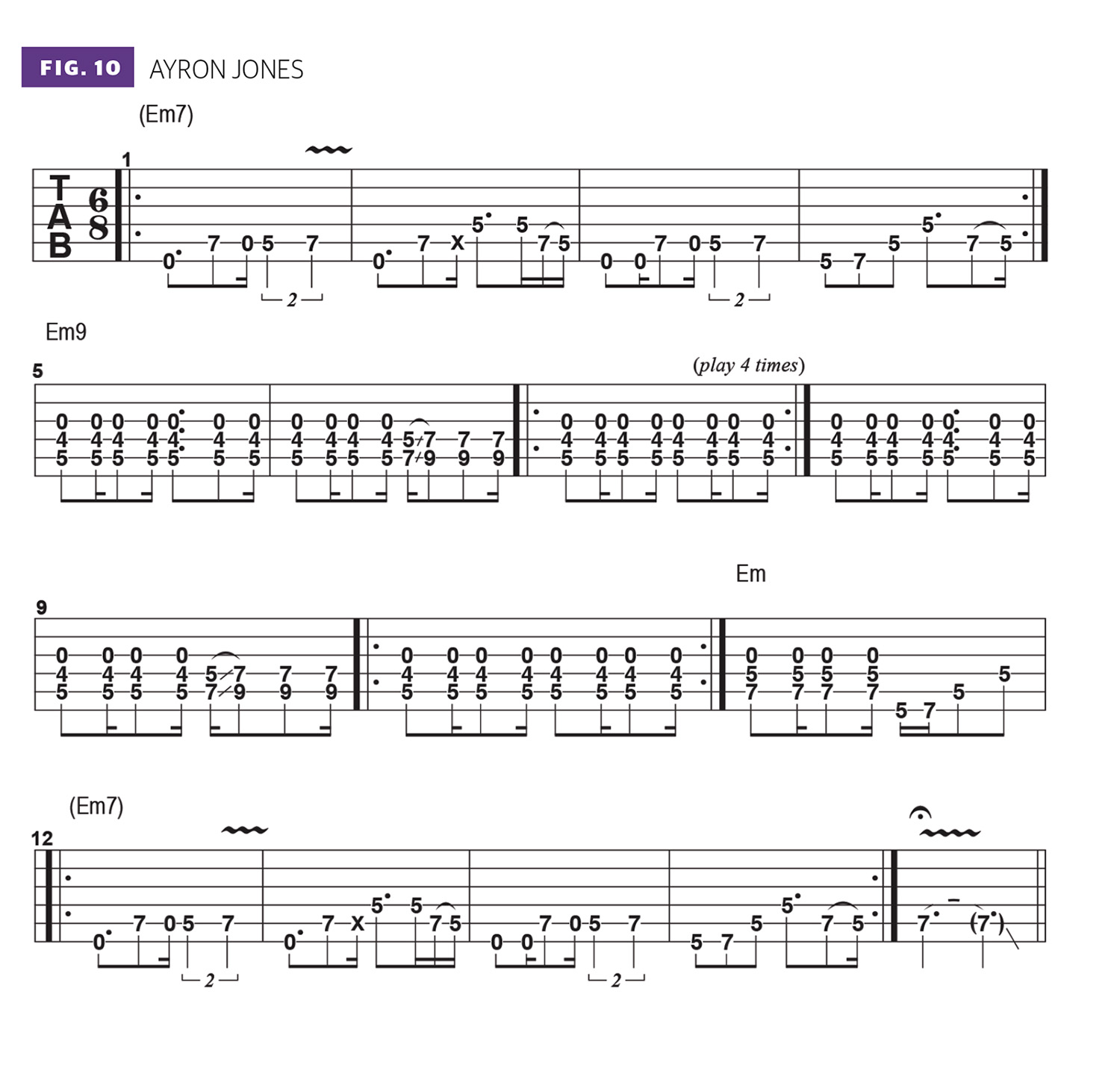
Figure 11 is a solo played in Jones’ style. We start off in the 12th- position box shape for E minor pentatonic (E, G, A, B, D) with an oblique bend; a note on the G string is bent while a note on the B string is held stationary.
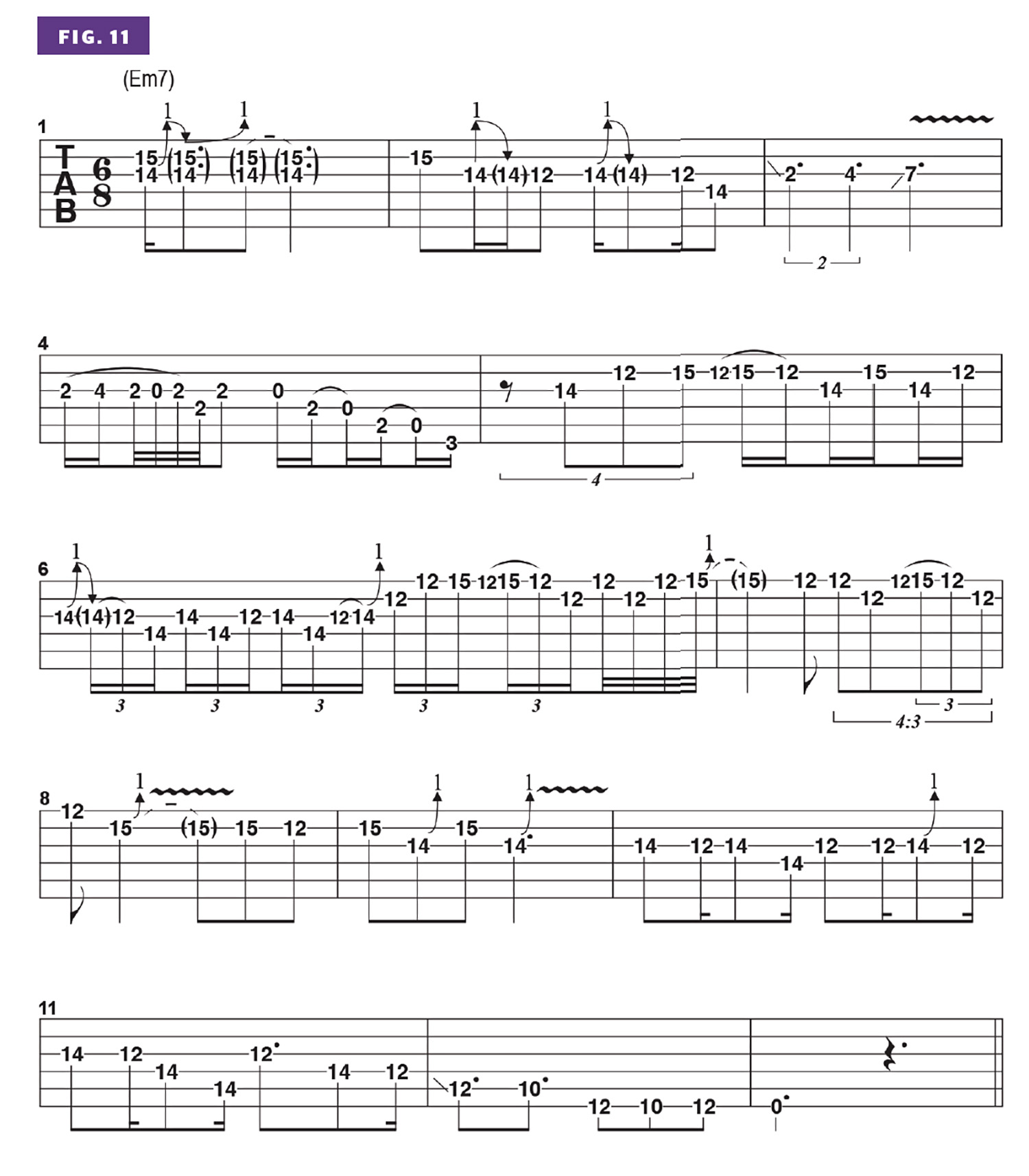
In bar 3, the phrase shifts quickly down and then back up the G string. Hendrix employed these techniques in many of his solos, such as those in Machine Gun and Spanish Castle Magic.
The lick in bar 6 is a fast flurry of notes, reflecting a technique often referred to as “cramming.” The solo then wraps up with melodic lines that sit firmly in the heavy 68 groove.







